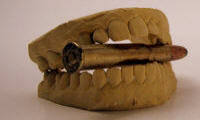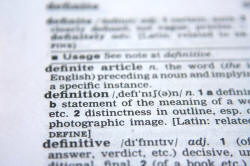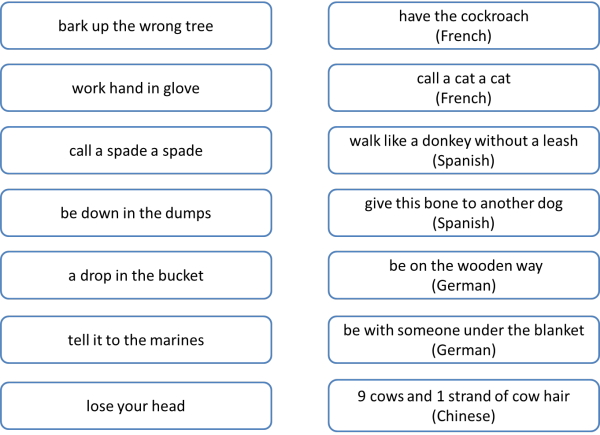Idiomaticity
What springs to mind when you see these images? Click here when you have thought of 6 expressions.
 |
 |
 |
 |
 |
 |
- bite the bullet (suffer an unpleasant and unavoidable situation)
- I'm all ears (I'm listening carefully and am interested)
- a piece of cake (an easy and enjoyable task)
- burn the candle at both ends (work late into the night and begin again in the early morning, thus exhausting oneself)
- let the cat out of the bag (reveal a secret)
- pull someone's leg (play a joke on someone by telling a lie)
There are two important characteristics of the expressions
in black. What are they?
Click here when you have an answer.
- non-compositionality
- this simply means that you can't get the meaning of the expression even if you know all the words in it. There is no way (without clear context) to guess, e.g., what let the cat out of the bag means.
- fixedness
- all the examples of idioms above are fixed: you can't replace
any of the words (except someone in the last case with a
name or pronoun), you can't leave out any of the words and you
can't insert words.
You can, naturally, bite a stick, burn a hurricane lamp, let the donkey out of the stable, release the cat from the bag, bite the 6mm bullet and pull someone's ear but none of the expressions will have the same meanings as these examples.
For a little more on semantics and noncompositionality, consult the guide to semantics linked in the list of related guides at the end.
So, idioms are non-compositional and fixed. End of story,
right?
Not quite, no.
 |
Definitions |
An early definition of an idiom comes from the linguist and teacher Henry Sweet (a major influence in the Reform Movement's reaction to grammar-translation approaches, incidentally). He stated:
The meaning of each idiom is an isolated
fact which cannot be inferred from the meaning of the words of which the
idiom is made up.
(Sweet, 1889:139)
Since Sweet's time, the area has been continually revisited by researchers interested in finding out what constitutes idiomaticity in languages and how the various types of idiom can be classified and analysed. What we have ended up with is a confusing muddle of terms, definitions and classifications which is, to say the least, unhelpful. You may, for example, come across any or all of the following terms if you research this area:
| figurative idioms or non-compositional metaphors | to refer to fact that we can often find a connection between figurative, idiomatic and literal meaning. It is for example, just possible to figure out what bite the bullet might mean with some knowledge of pre-anaesthetic surgery. Ditto, perhaps, with have an ace up one's sleeve |
| binomials | to refer to expressions such as time and again, Ladies and Gentlemen which occur as pairs of words, often with a fixed ordering |
| fixed expressions | to refer to idioms which are truly fixed such as an open and shut case |
| semi-fixed expressions | to refer to idioms where some flexibility is allowed. For example, you can throw in the towel but also throw in the sponge, both meaning surrender, and both derived from boxing |
| lexicalised expressions | to indicate that the expression functions as a single lexeme. For example, kick the bucket actually just functions as the verb die |
| opaque expressions | emphasising the fact that is often not possible to work out metaphoric meaning from literal meaning as it is with figurative metaphors. For example, chew the fat |
| frozen collocations | emphasising the fixedness characteristic of some idioms such as a can of worms |
| restricted collocations | referring to those which allow some flexibility but only within a limited range. For example, you can be a big/large/huge fish in a small/little/tiny pond |
| semi-idioms | to refer to anything which seems like an idiom, insofar as it acts like a single word, but is not completely opaque and fixed. One part of the expression has a figurative meaning not found elsewhere but the other part is 'normal' as in expressions such as pay attention or foot the bill |
It is not the suggestion here that such refinements are useless or
deliberately confusing but we are interested in classifications which
will be useful to us as English-language teachers rather than research
linguists so this guide will focus on two the central characteristics of
idiomatic language: fixedness and opacity
(or non-compositionality, if you prefer).
This will be at the expense of some precision so if you are looking for
more, there are references at the end to on-line, more scholarly
articles that you may want to read.
In some analyses, the definition of an idiom includes both fixedness
(the inability to change any of the components) and opacity
(non-compositionality) but both these phenomena exist on a scale from
fully fixed and opaque through semi-fixed and opaque to variable and
easily understood. The definition soon breaks down.
 |
Origins |
Although this distinction is not necessary for teaching purposes, it is sometimes helpful in terms of memorisation to know the origin of the idiom one encounters. There are two possible sources (which often overlap):
- Fixed metaphor
Frequently, very influential texts in English, such as the bible, Shakespeare's works and others, contain metaphors which have come into everyday use and become fixed idioms. Some metaphorical uses are obscure in origin. Examples include:
heart of gold
laughing stock
wild goose chase
wear your heart on your sleeve
(all from Shakespeare)
at the eleventh hour
by the skin of your teeth
a millstone around your neck
the writing on the wall
(all biblical)
it gives me the creeps
go on the rampage
(both from Charles Dickens)
spill the beans
straight from the horse's mouth
let the cat out of the bag
count your chickens before they are hatched
out to lunch
just my cup of tea
(all obscure in origin but some may conveniently but speculatively be derived from some occupations) - Historical and specific register origins
Other idioms derive from certain registers: sport, the military, trade, sailing and so on and are often opaque without a certain amount of knowledge of the history of the domains. They are usually not completely opaque, however.
Examples include:
a sticky wicket (from cricket)
cover all the bases (baseball)
run with the ball (rugby or American football)
game, set and match (tennis)
a level playing field (many sports)
plant a seed (horticulture)
plough through (farming)
cut a deal (obscure but possibly from card games)
hit a snag (angling or river navigation)
a loose cannon (from naval warfare)
flash in the pan (musketry)
close ranks (army parade term)
half-baked (cookery)
cut and dried (herbalism)
sail close to the wind (sailing)
 |
Fixedness |
This is not an on-off characteristic. Some idioms are more fixed than others, some are very flexible. Here's a cline for you to see what's meant. Where would you put the idioms on right in the cline on the left (if idioms they actually are)? Click on the image for some comments when you have an answer.
 |
through thick and thin hammer and sickle aid and abet have a blast hit the sack off one's rocker call it a day assets and liabilities left, right and centre |
life or death back to the drawing board cut corners put all your eggs in one basket torrential rain wouldn't be caught dead miss the boat make the grade make the beds raining cats and dogs |
On the left hand end of the cline, we can arrange those idioms which are clearly fixed in which we cannot add words, replace words or delete words without changing the meaning entirely. These include:
- hammer and sickle, aid and abet, life or death
- These are fixed-order binomials, sometimes called frozen
binomials. You can't reverse the order without sounding
odd and neither part can be replaced to maintain the meaning.
Nor can you insert anything between the parts. When they
are nouns, such binomials are treated as singular in English (the hammer and sickle
is, thunder and lightning was
etc.).
They belong on the far left. - left, right and centre
- This is similar but is actually called a trinomial (for a
pretty obvious reason). Other examples are:
blood, sweat and tears; cool,
calm, and collected; win, place, or show; tall, dark and
handsome and so on.
True trinomials like these belong on the left of the cline. - call it a day, cut corners, put all your eggs in one basket, wouldn't be caught dead, miss the boat, make the grade, raining cats and dogs, through thick and thin
- These are all fixed idioms. The last of these (through
thick and thin) is often classed as a fixed
binomial. We can't vary the order of words, insert words,
replace words or delete words in these expressions. We
can't have
put all your eggs in one tray
miss the train
rain cats and monkeys
call it a busy day
cut sharp corners
if we want to retain the meaning.
Note, however, that even with fixed idioms, we can alter the tense and must make the pronouns agree (they called / are calling it a day, he missed / will miss the boat, she'll never make the grade etc.) Other structural changes are possible but very rare such as cut a corner but most are forbidden such as *put all your eggs in baskets or *make the grades.
They belong on the far left of the cline.
On the right we have the most flexible expressions and there are only two of these:
- torrential rain, make the beds
- These are strong collocations because there is a limited
number of possible substitutions with verb + the beds
or torrential + noun. We can, just possibly, have
do the beds and make up the beds and have
torrential waterfalls or torrential rivers but
it's hard to find more replacements. The other way round,
however, produces a wider range of possibilities. The verb
make collocates with an enormous number of nouns (mistakes,
haste, mess etc.) and the number of possible adjectives for
rain is also large (heavy, light, drizzly, hard, thin
etc.). However, some strong collocations are so
predictable as to constitute real idioms. For example,
We pay attention, a compliment and our respects but take an interest, offence, place etc. and give explanations, thanks and promises etc.
It is quite arguable that collocations of this sort do not fully qualify at all as idioms and won't be considered further here. There is a separate guide to collocation on this site, linked below.
The rest of the expressions fall somewhere in the middle of the cline:
- have a blast, hit the sack, off one's rocker, back to the drawing board
- These all have alternates with the same or a very similar
meaning so they are semi-fixed idioms. We can have:
have a hoot
have a whale of a time
hit the hay
off one's trolley
back to square one
which all carry the same sorts of meaning, although they are sometimes stylistically different. Expressions such as these only have a very limited number of alternatives and they belong on the mid-left of the cline. They share other characteristics with true fixed expressions in not allowing deletions or insertions but a severely limited range of alternate words is possible. - assets and liabilities
- This is rather an unusual case because it is a binomial but the
ordering is not fixed (although this is the preferred one).
Other examples of binomials which do not have fully fixed ordering
include:
salt and pepper
see and hear
friends and family
etc.
There is usually a preferred order with all binomials but the reasons for it are complex. See Benor and Levy (no date) for a technical discussion.
There is an interesting exception to fixedness.
Some idioms and even binomials which are normally considered wholly
fixed can be modified with intensifiers. It is possible,
therefore, to have:
I have been rushing hither and
bloody yon all
day
I smell an
extremely large rat
I've missed the
damn/an important boat
have a
total/absolute/complete blast
etc. In particular, the so-called taboo words, bloody,
bleeding, damn etc., are used in this way.
Idioms may be flexible to a certain extent, then, but the flexibility is also analysable by type.
- Conjugation
Idioms which contain verbs are frequently conjugated to conform to the normal rules so, e.g.:
pass the buck
may be
passes, passed, is passing the buck
and so on and the verb can be nominalised as in:
I resent your passing the buck
Pronouns will change in the normal way and may be accompanied by other changes, e.g.:
She bit off more than she could chew
He has bitten off more than anyone could chew - Passivisation
Such idioms can also be made passive so we can allow
They have cooked the books
and
The books have been cooked - Insertion of words (usually adjectives or adverbs)
right at the eleventh hour
teaching new tricks to a very old dog
by the absolute skin of my teeth - Re-formulation
We need a level playing field → We need to level the playing field
She has a heart of gold → Her heart is of pure gold
 |
Opacity or non-compositionality |
Again, there's a cline because there are levels of opacity and
transparency. The image below separates them into those whose
meaning is obvious (literal), those where it can be deduced
(figurative uses) and those which are wholly opaque.
As you did above, locate these expressions on the right somewhere on the
cline on the left and then click the image for a commentary.
 |
barking up the wrong tree a bitter pill to swallow by the skin of one's teeth bread and circuses kiss and tell heads or tails spick and span holding all the aces at a snail’s pace |
a dime a dozen bite off more than one can chew cut the mustard bob and weave under the weather hot and bothered research and development come rain or shine Tom, Dick and Harry |
Very few of these idioms are going to be on the
far left of the cline. If they were, they would hardly qualify as
idioms at all.
So, we have the first group of idioms whose meaning can be worked out
quite easily from their literal interpretation or whose meaning
is literal, in fact.
- heads or tails, a dime a dozen, research and development, at a snail's pace
- These are the most literal. It is easy to work out what
they mean from understanding their constituents. Many bi- and
tri-nomials fall into this category:
knife and fork
law and order
salt and pepper
sick and tired
red, white and blue
sex, drugs, and rock 'n' roll
etc. Many do not have transparent meanings, however, such as
I'm all fingers and thumbs
It's neither fish nor fowl
Most idioms do not fall into this category.
The figurative section is the most crowded and it's a matter of opinion whether an expression falls to the left or right of the centre of the cline.
- barking up the wrong tree, a bitter pill to swallow, kiss and tell, holding all the aces, bite off more than one can chew, hot and bothered, come rain or shine
- In many of these sorts of expressions, only one of the items is
used figuratively so it's possible to work out what's meant.
In others, it is a short step from the literal to the metaphoric
meaning. For example, imagining a picture of a dog barking up
the wrong tree immediately allows you to make the jump to the
metaphorical meaning of barking up the
wrong tree. Equally, if you know something about
many card games, you'll know that
holding all the aces is likely to lead to a win.
Even kiss and tell needs
little context for you to understand its meaning.
With binomials and some other idioms, it's possible to assume that the terms are synonyms or antonyms of sorts and understanding one allows you to understand the whole. hot and bothered and come rain or shine fall into this category.
Finally, there are the wholly opaque idioms:
- by the skin of one's teeth, spick and span, cut the mustard, bob and weave, under the weather, Tom, Dick and Harry
- All these are opaque and you'd have to be very lucky to guess
their meaning even with context to help. Many idioms are like
these and they have to be learned as single units of meaning.
There are also a number of common binomials in which one or both items is only seen in that context. The example here is spick and span but others include:
to and fro
harum-scarum
helter-skelter
hem and haw
nip and tuck
etc.
 |
The relationship between fixedness and opacity |
There is a tendency for these two characteristics to rise and fall together. In other words, the more fixed and inflexible the expression, the more likely it is to be opaque in meaning and vice versa.
We can find low fixedness with some expressions but they are likely
to be quite literal in meaning. For example,
as old as ... can be followed
by a number of expressions (God, the hills, Noah etc.) but
opacity is also low.
Similarly, strong collocations such as
a pronounced accent are not firmly fixed (we can have
strong, broad etc. as the adjective with roughly the same meaning)
but they are usually easy to understand (if not to learn).
On the other hand, an expression such as off one's rocker has quite high fixedness (there's only one conventional alternative to rocker, trolley) and it is also quite high in opacity. Extreme cases of fixedness are also, often, extreme cases of opacity. Expressions such as let the cat out of the bag are both opaque and fixed as are binomials such as helter-skelter.
There are, nevertheless, instances, especially with binomials, of low
opacity and high fixedness. In other words, they always occur
together and in the same order but are straightforward to understand.
Examples are:
here and there
hand in hand
dead and buried
etc.
The moral?
Whenever we find a highly opaque expression, the way to bet is that it
is also firmly fixed. The reverse is not always true.
Here's a graphical representation of that. Before teaching idioms,
it is worth 5 minutes of the planning time to consider where in the
matrix the target language items fall.

 |
 |
Binomials and trinomials |
Because these are so common in English, they merit a short section to
themselves. Many of these items are worth teaching as single
lexemes because they are handy language chunks, they are extremely
common and they are not easily paraphrased.
There are some general characteristics of binomial expressions:
- They consist of two lexical items belonging to the same word
class so they are, noun + noun, verb + verb, adjective +
adjective, adverb + adverb. Examples of the four main
sorts are:
He has lived here man and boy
You can take it or leave it
And that's the truth, pure and simple
I will do it sooner or later
(Rarely, the two items are not of the same word class but follow similar structural forms so, for example:
We were home and dry
in which home is an adverb and dry an adjective but both are joined to the subject by the copular verb. That is probably not something with which to trouble your learners.) - Some are literal (apples and oranges etc.), some are figurative (the chicken or the egg etc.) and some are wholly opaque (milk and honey etc.).
- Some, such as helter-skelter, super-duper etc., contain words found nowhere else.
- When two nouns are joined, the resulting expression is
often singular, e.g.:
Fire and brimstone is all he shouts about
Thunder and lightning is on its way
but, if the nouns are already plural, that is not the case:
His eyes and ears are everywhere
The stars and stripes are flying over The White House - The order of the items is usually fixed although with some,
reversal has no effect. We can have:
She worked day and night
and
She worked night and day
We allow
I'll do it sooner or later
but not
*I'll do it later or sooner - The tenses and numbers of items are normally retained in
both items so we get, for example:
It's done and dusted
It comes with many bells and whistles
I'll name and shame him
There will be some naming and shaming
They were named and shamed
etc. and:
*for all intent and purpose
*It's time to cut and be running
are not encountered. - The items are frequently joined with the coordinator and but there are other possibilities including: but, or, either ... or, neither ... nor, to, after, by, in.
- Often the items rhyme or are, more often, alliterative as
in, e.g.:
make or break
high and dry
house and home
do or die
etc.
In some, a phenomenon called assonance is discernible so for example, a stressed vowel will be the same in both items or a consonant duplicated with different vowels as in harum scarum or tittle-tattle. - Because binomials operate as single lexemes, they are
subject to the collocational forces as all other lexemes so, for
example:
high and dry collocates strongly with the verb leave
high and low collocates with verbs such as look (for), search, hunt and seek
dead and buried collocates with nouns such as ideas, proposals, suggestions, schemes and plans
and so on. - Binomials often intensify, especially reduplicative ones,
so, e.g.:
She went from strength to strength
Ones in which the two items are synonyms have the same effect:
He's at my beck and call
and, perversely, antonym pairs also intensify:
We searched high and low, in and out, in each and every part of the house
Here's a selection.
Fuller lists with some doubtful inclusions are available via a web
search.
joined with coordinators (and or or/neither ... nor etc.)
| above and beyond airs and graces alive and kicking all or nothing an arm and a leg apples and oranges assault and battery back and forth ball and chain beck and call beer and skittles bells and whistles for better or worse bits and bobs bow and arrow by and large cat and mouse the chicken or the egg cut and dried cut and run day or night dead and buried dead or alive divide and conquer do or die down and out each and every eyes and ears far and wide fast and loose fingers and thumbs fire and brimstone first and foremost forever and a day free and clear fight or flight (neither) fish nor fowl fun and games (come) hell or high water (neither) here nor there hit or miss hale and hearty hard and fast hearts and minds here and now high and dry high and low home and dry hope and pray |
horse and carriage intents and purposes kill or cure kill or be killed knife and fork law and order love nor money lo and behold loud and clear make or break man and boy milk and honey more or less nip and tuck nook and cranny nuts and bolts odds and ends pure and simple pepper and salt (colouring) rags to riches rain or shine research and development room and board sink or swim sooner or later take it or leave it salt and pepper (seasoning) seek and destroy short and / but sweet sick and tired slash and burn smash and grab snakes and ladders stand and deliver supply and demand sweetness and light tables and chairs tar and feather tea and crumpets thunder and lightning time after time to and fro tooth and nail touch and go trial and error up and about vim and vigour wait and see wine and roses |
with reduplication
The term reduplicate is a slight misnomer because the words are
duplicated, not reduplicated.
| again and again all in all around and around arm in arm back to back bit by bit bumper to bumper by and by cheek to cheek closer and closer coast to coast day to/ by day elbow to elbow end to end dog eat dog from ear to ear an eye for an eye eye to eye face to face hand in hand head to head heart to heart higher and higher horror of horrors less and less |
little by little lower and lower man to man more and more mouth to mouth neck and neck never say never nose to nose on and on out and out over and over round and round shoulder to shoulder side to side step by step strength to strength through and through time after time (from) time to time two by two toe to toe up and up wall to wall for weeks and weeks woman to woman |
with rhymes or similar sounds
These are often considered a subset of reduplicate phrases but exactly where the border is between a reduplicative and these examples lies is not always easy to determine.
Parts of the words are clear duplicated and the words often rhyme, a
phenomenon encapsulated in the alternative name, ricochet words.
The use or not of a hyphen is often idiosyncratic to the writer as is
whether some are written as one word.
| belt and braces box and cox chalk and talk chit-chat dilly-dally ding-dong double trouble even Stevens fender-bender flim-flam flip-flop hanky-panky harum-scarum helter-skelter higgelty-piggelty high and dry hire and fire hither and thither hobnob hocus-pocus hodge-podge hoity-toity horses for courses hubble-bubble huff and puff hurly-burly |
hustle and bustle meet and greet mish-mash namby-pamby name and shame near and dear nitty-gritty odds and sods out and about pell-mell ping-pong pitter-patter razzle-dazzle riff-raff roly-poly shillyshally time and tide tip-top tittle-tattle town and gown use it or lose it wear and tear willy-nilly wine and dine wishy-washy yea or nay |
patter is a reduction of pat-pat (to hit gently).
blabber is a reduction of blab-blab
paddle is a reduction of pad-pad
and so on.
The technical term for this phenomenon is that the word is a frequentative.
There are fewer of these and they almost always employ and as the coordinator. Examples include:
| beg, borrow or steal blood, sweat and tears cool, calm and collected eat, drink, and be merry ear, nose and throat gold, silver, and bronze guns, germs, and steel healthy, wealthy, and wise here, there and everywhere hook, line and sinker hop, skip and jump judge, jury and executioner left, right and centre lights, music, action |
lock, stock and barrel nasty, brutish and short planes, trains, and automobiles ready, willing and able reading, writing and arithmetic red, white and blue sex, drugs, and rock 'n' roll sugar and spice and everything nice tall, dark and handsome Tom, Dick and Harry shake, rattle and roll this, that, and the other way, shape, or form win, lose, or draw |
hyphenation
Many binomials, especially those without a connecting conjunction,
are conventionally hyphenated so we get helter-skelter, willy-nilly,
harum-scarum and so on.
Others are only hyphenated when they are used adjectivally so we get,
for example:
It's a question of law and order
The price is subject to the influence of supply and demand
etc., because these are being used as nouns, but we have:
This is a law-and-order issue
It's a supply-and-demand influence
etc., because these are adjectival uses.
Trinomials exhibit the same phenomenon.
 |
Fixed similes |
Similes explicitly compare two items, usually, in
English, with the as ... as formulation.
A number of these constitute a kind of idiom although in almost all
cases they are a) fixed and b) often (but not always) quite literal and
transparent in meaning. They include items such as:
as blind as a bat
as cool as a cucumber
as fit as a fiddle
as fresh as a daisy
as good as
gold
as keen as mustard
as light as a feather
as old as the hills
as regular as clockwork
as right as rain
as safe as houses
as strong as an ox
as stubborn as a mule
as thin as a rake
etc.
Such expressions, too, are often formed from rhyming (or near rhyming)
items and are often alliterative.
The main elements are also, again, usually given equal stress.
A secondary form for these fixed expressions employs the like
preposition. These are not adjectival so often it is a noun
being compared to another or a verb being used figuratively as in
eyes like a hawk
a face like a brick wall
a hand like a bunch of bananas
drink like a fish
smoke like a chimney
fight like cat and dog
eat like a horse
eat like a bird
run like clockwork
cry like a baby
spin like a top
work like a Trojan
be / behave:
like a child in a sweet shop
like a bull in a china shop
like a dog with two tails
like a headless chicken
like watching paint dry
They are almost totally confined to informal speech and writing.
Such clichés are often disparaged in more formal texts.
 |
Style and register |
Most idiomatic language is stylistically informal and
inappropriate in a number of situations. Idioms are used
extensively in informal speech and writing (especially in
newspapers), however, so a knowledge of common ones is very helpful
for learners of English. Unfortunately, there are, by some
estimates, 25,000 of them in English.
In more formal contexts, idioms will often be avoided so we are
unlikely to find, for example:
Buckingham Palace announced that the Queen is under the weather
The government negotiators are reluctant to open a can of worms,
said the White House spokesman.
etc.
Learners of the language can be tempted to overuse idiomatic
language in situations where it is not appropriate or they can get
the meaning just slightly wrong and produce, e.g.:
*I'll do it willy-nilly
*The government isn't cutting the mustard for it
In common with many idiomatic expressions, bi- and trinomials are
often informal and common in spoken language.
A few, however, such as first and foremost, more and more,
intents and purposes and others are encountered in formal
writing and some are confined to specific registers such as
economics (supply and demand), the law (aid and abet),
education (reading, writing and arithmetic) or engineering,
politics and commerce (research and development, wear and tear, trial and error, ways and
means).
They are, to some extent, clichés and accordingly much used in
journalese.
The same considerations of grammar and form apply here as they do in
the teaching of any lexis.
It is important to make sure, then, that idiom presentation is set
in an appropriately context (both style and register) and that word class is considered along
with aspects of transitivity and so on.
 |
Pronunciation |
-
Most binomials are evenly stressed with the coordinating item
being weakened. We get, therefore:
name and shame /ˈneɪm.n̩.ˈʃeɪm/
fun and games /ˈfʌn.n̩.ˈɡeɪmz/
tittle tattle /ˈtɪt.l̩.ˈtæt.l̩/
shoulder to shoulder /ˈʃəʊl.də.tə.ˈʃəʊl.də/
A few may operate like compound nouns and take the stress on the first element, e.g.:
near and dear (/ˈnɪər.n̩.dɪə/)
but stressing both components equally is more common. - Trinomials are lists but, because they are processed as
single units, the normal list intonation, with rises after each
item and a fall at the end, is compromised. We may get,
therefore, for example:
game, set and match
pronounced as
/ˈɡeɪmset.n̩.ˈmætʃ/
rather than
/ˈɡeɪm.ˈset.ənd.ˈmætʃ/
with the normal pause after the first item and equal stress on all the items.
More commonly, the stress on each item is retained but the intonation does not rise as it would in a list of less connected items:
beg, borrow and steal /ˈbeɡ.ˈbɒ.rəʊ.n̩.ˈstiːl/ - Many idioms operate as single lexemes and only one tone unit
is discernible so we have, e.g.:
I wouldn't be caught dead
/ˈaɪ.wʊdnt.bi.kɔːt.ˈded/
with only two stressed syllables.
Compare:
I wouldn't do that if I were you:
/ˈaɪ.wʊd.də.ˈðət.ɪf.ˈaɪ.wə.ˈju/
with four stresses. - Because of their single lexeme nature, idioms are spoken
rapidly as one chunk so syllable reduction and weak forms are
common. E.g.:
She's bitten off more than she can chew
is often pronounced as
/ʃiz.ˈbɪt.n̩.ə.mɔː.ðən.ʃi.kn̩.tʃuː/
with two syllabic consonants and weak forms (/ə/, /i/). See, too, the pronunciation of and in the binomial examples which is often reduced to a single syllabic consonant (/n̩/).
 |
Teaching idiomatic language |
Too often, in coursebooks and study guides, idioms and idiomatic language are relegated to peripheral 'Useful phrases' boxes and then ignored. That's a great pity as it is almost impossible to become fluent in English without acquiring a fair number of idiomatic expressions. In fact:
Most students
are very interested in learning idiomatic language. They recognize
it as an area in which they have difficulties, and appreciate systematic
instruction.
(Irujo, 1986: 242)
There's nothing mysterious about this. We have to make the same judgements that we make when teaching lexis of any sort. In other words, we must consider appropriacy and style, range, learnability, frequency and so on. For more, see the guide to teaching lexis, linked below.
However, idioms and idiomatic language have some characteristics that make certain approaches more worthwhile and productive.
- Context
Idioms occur more naturally in informal story-telling language so that's a good place to situate them. Context will also help learners appreciate issues of style and co-text will often disambiguate meaning successfully. - Illustrations
Because idioms are so picturesque, it makes it comparatively easy to link them to illustrations (see the introduction to this guide for examples). - Figurative meaning
Group and pair-work to decipher figurative meaning is helpful because people see different things in language and have different mental metaphors so they can help each other significantly. Obviously, the more transparent the meaning is, the less hard the expression will be to understand and learn. - Retelling stories
Retelling exercises can be a powerful way of consolidating idiomatic language as can dialogue writing and creative story writing. - Translation
Idioms rarely translate exactly between languages but it is surprising how similar concepts are encoded in idiomatic language. For example, the expression it cost an arm and a leg is rendered in Spanish with something like it cost an eye of your face and in German, a hook in the matter means there's a fly in the ointment. All languages exhibit a rich and picturesque range of metaphorical meaning. It can be educational, interesting and fun to compare how meanings are encoded in various languages and that, too, can help retention.
Here are some examples for fun. Can you match the English idioms on the left to their equivalents in other languages on the right? Click on the image when you have an answer.
You can, of course, get your learners to make up quizzes like this and challenge others to find the English equivalent or figure out the meaning.
More teaching ideas can be found in Irujo (1986)
In the section for learners on this site, there are some exercises to do with idioms and binomials. Check the exercise index under vocabulary for more.
There is a very short test on some terms to help you recall all this.
| Related guides | |
| synonymy | for more on how this and related areas work with more on similes and metaphors (fixed and otherwise) |
| semantics | for a theoretical guide to meaning |
| teaching lexis | for some practical ideas |
| collocation | for more on this form lexical relationship |
References:
Barkema, H, 1996, Idiomaticity and terminology: a multi-dimensional
descriptive model, Blackwell Publishing Ltd., Studia Linguistica,
Volume 50, Issue 2, pp. 125-160
Benor, SB & Levy, R, no date, The Chicken or the Egg? A
Probabilistic Analysis of English Binomials, available from
http://www.pdfmanuale.com/file/9GW/the-chicken-or-the-egg-a-probabilistic-analysis-of-english.html
[accessed January 2015]
lrujo, S, 1986, A piece of cake: learning and teaching idioms,
English Language Teaching Journal, 40 (3) pp. 236-242, Oxford: Oxford
University Press
Moreno, REV, no date, Idioms, Transparency and
Pragmatic Inference, available from
http://www.phon.ucl.ac.uk/publications/WPL/05papers/vega_moreno.pdf
[accessed January 2015]
Sweet, H, 1889, The practical study of languages, London:
Oxford University Press (Reprinted in 1964)
